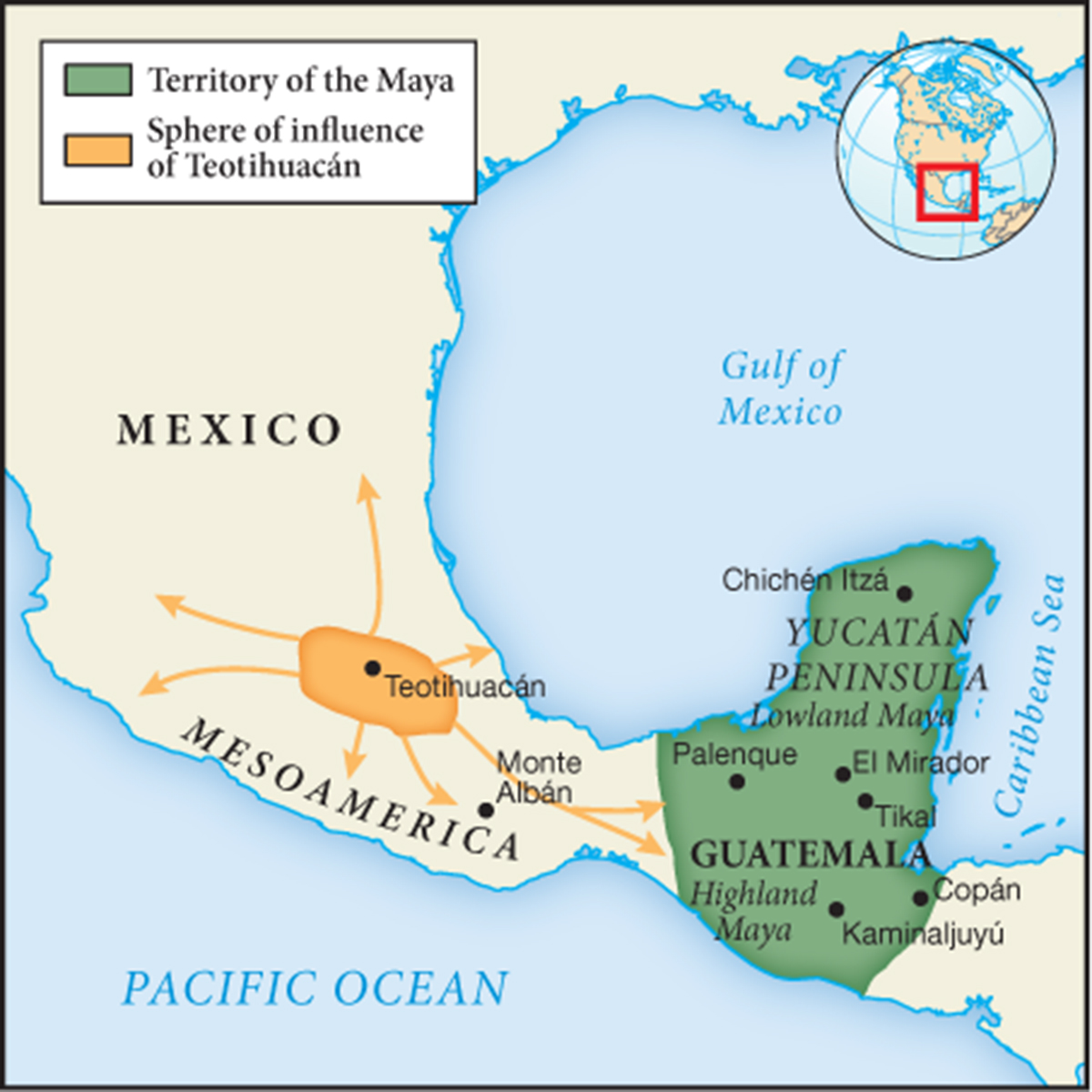Ways of the World with Sources
Printed Page 242
Ways of the World
Printed Page 208
Chapter Timeline
The Maya: Writing and Warfare

Map 6.2 Civilizations of Mesoamerica During the second-wave era, Maya civilization and the large city of Teotihuacán represented the most prominent features of Mesoamerican civilization.
Among Mesoamerican civilizations, none has attracted more attention than that of the Maya. Scholars have traced the beginnings of the Maya people to ceremonial centers constructed as early as 2000 B.C.E. in present-day Guatemala and the Yucatán region of Mexico (see Map 6.2). During the first millennium B.C.E., a number of substantial urban centers with concentrated populations and monumental architecture had emerged in the region. In northern Guatemala, for example, the archeological site of El Mirador was home to tens of thousands of people, a pyramid/temple said by some to be the largest in the world, and a stone-carved frieze depicting the Maya creation story known as the Popul Vuh.
But it was during a later phase of Maya civilization, between 250 and 900 C.E., that their most well-known cultural achievements emerged. Intellectuals, probably priests, developed a mathematical system that included the concept of zero and place notation and was capable of complex calculations. They combined this mathematical ability with careful observation of the night skies to plot the cycles of planets, to predict eclipses of the sun and the moon, to construct elaborate calendars, and to calculate accurately the length of the solar year. The distinctive art of the Maya elite was likewise impressive to later observers.
With what Eurasian civilizations might the Maya be compared?
Accompanying these intellectual and artistic achievements was the creation of the most elaborate writing system in the Americas, which used both pictographs and phonetic or syllabic elements. Carved on stone and written on bark paper or deerskin books, Mayan writing recorded historical events, masses of astronomical data, and religious or mythological texts. Temples, pyramids, palaces, and public plazas abounded, graced with painted murals and endless stone carving. It is not surprising that early scholars viewed Maya civilization somewhat romantically as a peaceful society led by gentle stargazing priest-kings devoted to temple building and intellectual pursuits.
The economic foundations for these cultural achievements were embedded in an “almost totally engineered landscape.”7 The Maya drained swamps, terraced hillsides, flattened ridgetops, and constructed an elaborate water-management system. Much of this underpinned a flourishing agriculture, which supported a very rapidly growing and dense population by 750 C.E. This agriculture sustained substantial elite classes of nobles, priests, merchants, architects, and sculptors, as well as specialized artisans producing pottery, tools, and cotton textiles. And it was sufficiently productive to free a large labor force for work on the many public structures that continue to amaze contemporary visitors.
The earlier romantic view of Maya civilization changed as scholars realized that its many achievements took place within a highly fragmented political system of city-states, local lords, and regional kingdoms with no central authority, with frequent warfare, and with the extensive capture and sacrifice of prisoners. The larger political units of Maya civilization were densely populated urban and ceremonial centers, ruled by powerful kings and on a few occasions queens. They were divine rulers or “state shamans” able to mediate between humankind and the supernatural. One of these cities, Tikal (tee-KAHL), contained perhaps 50,000 people, with another 50,000 or so in the surrounding countryside, by 750 C.E. (See the chapter-opening photo of a temple from Tikal.) Some of these city-states had imperial ambition, but none succeeded in creating a unified Maya empire. Various centers of Maya civilization rose and fell; fluctuating alliances among them alternated with periods of sporadic warfare; ruling families intermarried; the elite classes sought luxury goods from far away—jade, gold, shells, feathers from exotic birds, cacao—to bolster their authority and status. In its political dimensions, Maya civilization more closely resembled the competing city-states of ancient Mesopotamia or classical Greece than the imperial structures of Rome, Persia, or China.
But large parts of that imposing civilization collapsed with a completeness and finality rare in world history. Clearly, this was not a single or uniform phenomenon, as flourishing centers of Maya civilization persisted in the northern Yucatán, and many Maya survived to fight the Spanish in the sixteenth century. But in the southern regions where the collapse was most complete, its outcomes were devastating. In less than a century following the onset of a long-term drought in 840, the population of the low-lying southern heartland of the Maya dropped by 85 percent or more as famine, epidemic, and fratricidal warfare reaped a horrific toll. It was a catastrophe from which there was no recovery. Elements of Maya culture survived in scattered settlements, but the great cities were deserted, and large-scale construction and artistic work ceased. The last date inscribed in stone corresponds to 909 C.E. As a complex civilization, the Maya had passed into history.
Explaining this remarkable demise has long kept scholars guessing, with recent accounts focusing on ecological and political factors. Rapid population growth after 600 C.E. pushed total Maya numbers to perhaps 5 million or more and soon outstripped available resources, resulting in deforestation and the erosion of hillsides. Under such conditions, climate change in the form of prolonged droughts in the 800s may well have placed unbearable pressures on Maya society. Political disunity and endemic rivalries, long a prominent feature of Maya civilization, prevented a coordinated and effective response to the emerging catastrophe. Warfare in fact became more frequent as competition for increasingly scarce land for cultivation became sharper. Rulers dependent on ritual splendor for their legitimacy competed to mount ever more elaborate temples, palaces, and pageants, requiring more labor and taxes from their subjects and tribute from their enemies. Whatever the precise explanation, the Maya collapse, like that of the Romans and others, illustrates the fragility of civilizations, whether they are embodied in large empires or organized in a more decentralized fashion.
